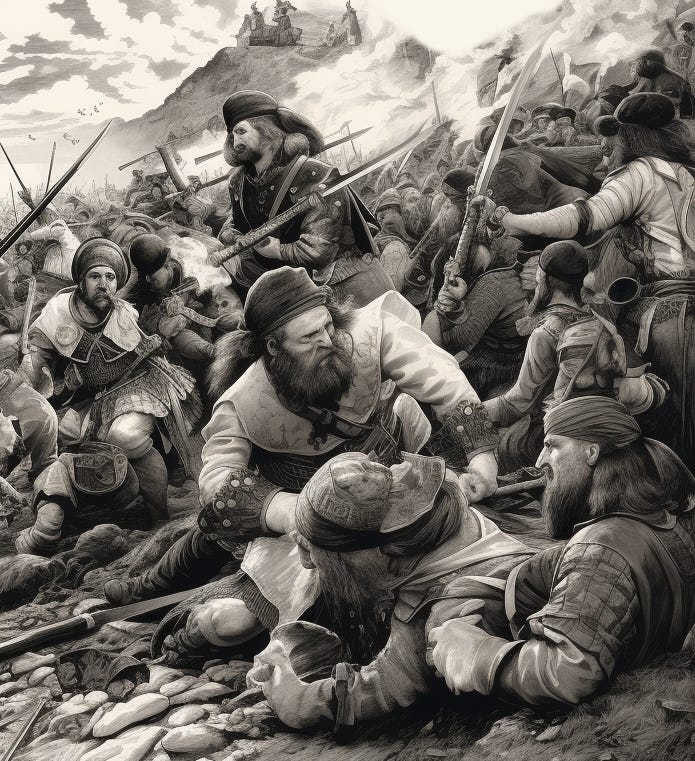The Centuries-Old Blood Feud: Clan Mackenzie vs. Clan Munro
Scotland's history is steeped in tales of fierce clan rivalries and blood feuds that have shaped the country's culture and traditions for centuries. Among these intense conflicts, one of the most notable is the feud between Clan Mackenzie and Clan Munro, two powerful Highland clans whose clashes left a lasting mark on Scottish history. In this post, we will delve deep into the origins, key events, and eventual reconciliation of the Clan Mackenzie and Clan Munro feud, exploring the tumultuous relationship that defined their interactions in the Scottish Highlands.
Read the new article from our daily premium feed : The Tale of Kenneth Mackenzie and Anne Fraser
The Origins of Clan Mackenzie and Clan Munro
Before we dive into the blood feud itself, it is essential to understand the historical context and origins of Clan Mackenzie and Clan Munro.
Clan Mackenzie: Keepers of Kintail The roots of Clan Mackenzie, also known as Clan Choinnich in Scottish Gaelic, can be traced back to Kenneth Mackenzie, the 1st of Kintail, who received lands in the western Highlands in the 13th century. Over time, the Mackenzies established themselves as a significant clan, particularly in the Kintail and Ross-shire regions, where they held vast territories.
Clan Munro: Defenders of Foulis Clan Munro, or Clann an Rothaich in Gaelic, takes its name from the Old Gaelic word "rothach," meaning "man of Ro," a reference to the clan's early leaders. The Munros settled in the Easter Ross region, with Foulis Castle as their stronghold.
The Feud Takes Shape
The feud between Clan Mackenzie and Clan Munro is believed to have been rooted in territorial disputes and political tensions. William Munro of Foulis, knighted by James IV, played a pivotal role in leading the Munros against the Mackenzies as part of his official duties.
The Battle of Drumchatt, which occurred around 1501, marked a significant turning point in the feud. A force of up to 900 men, including members of Clan Munro, Clan Dingwall, and Clan MacCulloch, attacked the Mackenzies, destroying their property and seizing cattle. Hector Roy Mackenzie, the Mackenzie chief, rallied around 180 clansmen to seek revenge.
Hector Roy Mackenzie recognized that facing the Munros head-on would be a disadvantage due to their overwhelming numbers. The Mackenzies devised a cunning plan to ambush the returning Munro force at Knockfarrel hill, near Drumchatt Ridge. The Mackenzies, armed with two-handed swords and battle axes, surprised the weary Munros and attacked with ferocity. Panic among the Munros led to a rout, and the Mackenzies inflicted significant casualties, leading to the gruesome legend of the "Fountain of Heads." Legend has it that the battle resulted in so many severed heads rolling down the hill that they accumulated in a nearby well, earning it the grim moniker "Fountain of Heads."
Fate of William Munro and Reconciliation
William Munro did not live long enough to seek vengeance against the Mackenzies for the Drumchatt massacre. While on official business for the king, William Munro was killed in a battle against the Camerons of Lochiel.
After William Munro's death, the clan feud was eventually settled. Hector Munro, the 13th Baron of Foulis and William's son, married the daughter of Kenneth Mackenzie, the 7th of Kintail and chief of Clan Mackenzie. This union served as a symbol of reconciliation between Clan Mackenzie and Clan Munro, ending the long-standing blood feud.
Legacy and Significance
The feud between Clan Mackenzie and Clan Munro left a profound mark on Highland history, contributing to the larger tapestry of Scottish clan conflicts. It serves as a reminder of the fierce rivalries and intricate alliances that defined life in the Highlands during this era.
Marriages played a crucial role in ending clan feuds and forging new alliances. The marriage of Hector Munro and a Mackenzie daughter exemplifies how such unions were used to promote peace among clans.
The Battle of Drumchatt and its gruesome aftermath left a lasting legacy in Highland folklore, with tales of the "Fountain of Heads" and other legends continuing to captivate imaginations.
Conclusion
The blood feud between Clan Mackenzie and Clan Munro stands as a testament to the complex history of Scotland's Highland clans. Rooted in territorial disputes and political rivalries, this feud culminated in the Battle of Drumchatt, leaving an indelible mark on both clans' histories. However, through the marriage of Hector Munro and a Mackenzie daughter, the two clans found a path to reconciliation, ultimately bringing an end to their long-standing conflict. Today, the legacy of this feud endures as a reminder of Scotland's rich and often turbulent past, where alliances, rivalries, and legends shaped the nation's history.





